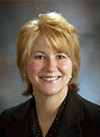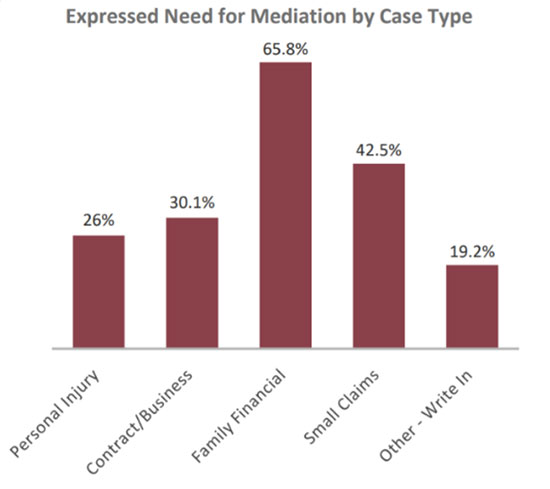
Aug. 5, 2020 – To increase access to justice, the State Bar of Wisconsin’s Dispute Resolution Section celebrated Mediation Week the third week of October under the direction of the section chair, Jim Reiher.
Mediators volunteered around the state to raise awareness. While initially successful, over time volunteers spent the day waiting for only one or two clients.
The Dispute Resolution Mediation Week Committee consisting of attorneys Amy Koltz, Lisa Derr, and Jill Hamill Sopha stepped back to discuss the status of mediation in Wisconsin. How could we better meet the objectives to raise awareness and increasingly use mediation? How was mediation currently being used across the state?
With the support of the chair, the Dispute Resolution committee partnered with Resolute Systems Institute (RSI), which had already done extensive work on judicial surveys.
The committee requested financial assistance from other state bar sections. Three contributed to the $6,500 cost including Litigation, Labor & Employment, and Appellate sections. The Wisconsin Association of Mediators contributed as well.
At the same time, the Planning and Policy Advisory Committee (PPAC) – which advises the Supreme Court and Director of State Courts on planning initiatives – had formed a subcommittee on using mediation in Wisconsin.
It naturally followed that Dispute Resolution committee partnered with RSI and PPAC1 to coordinate and distribute a survey to all 249 Wisconsin judges addressing:
-
The availability of mediation across the state;
-
The need for mediation in their respective counties;
-
What supported or impeded mediation;
-
Judicial referrals of cases to mediation and to specific mediators;
-
Views on benefits and suitability;
-
Whether perspectives differed based upon the practice area.
Main Findings
The committee was gratified to receive a 54 percent response rate from 134 judges covering 55 of 72 counties. The survey also divided responses into four practice areas to see how responses might vary based upon different practice areas.
The areas were consolidated to: personal injury; contracts/business; family financial (e.g. division of property & child support); and small claims.
The main findings of the judicial survey are:
-
As a group, judges view mediation positively, seeing more than one benefit and would use it in a variety of situations.
-
Mediation is generally available, but not widely accessible or used.
-
Mediation is most needed for family financial and small claims cases.
-
Personal injury cases had the least need as most judges refer more than half of those cases to mediation. Not surprisingly, the highest judicial referrals were also for personal injury cases. Most of those referrals were to attorney-mediators and to mediators who are former judges.
-
Judges perceive structural barriers to greater mediation use. In order of importance is the lack of funding, the cost to litigants and the lack of mediators. Attitudinal barriers were least cited as an obstacle. In fact, judges cited attorney interest as a major support of mediation.
 Lisa Derr (U.W. 1987) is a mediator with Derr & Villarreal and chair of the Dispute Resolution Section. She can be reached by email or by phone at (920) 885-5549.
Lisa Derr (U.W. 1987) is a mediator with Derr & Villarreal and chair of the Dispute Resolution Section. She can be reached by email or by phone at (920) 885-5549.
Some findings applied across case types. A majority (60 percent) believe that the traditional litigation system is not enough. Most (57 percent) believe there is an unmet need for mediation as an alternative or addition to the system, especially for family financial issues and small claims. Remaining judges (43 percent) felt that their counties’ need for mediation was being met.
Only 26 percent saw a need for personal injury cases, consistent with the finding that most believed that the need for mediation of personal injury cases was being met.
The majority feel there is an unmet need mainly for mediating family financial cases and small claims. One obstacle was a perceived lack of mediators.
The primary perceived obstacle for using mediation is insufficient funding and the second is the cost to litigants. This could mean that private mediators are available but not necessarily affordable and we lack funding sources to bridge that gap.
On a positive note, when asked about what supports mediation in their county, judges felt that attorney attitudes were not obstacles but a major support for mediation.
Just over three-quarters of judges felt that ordering mediation strongly supported that form of dispute resolution. Almost two-thirds of the judge felt that the availability of skilled mediators supported mediation.
As expected, there were discrepancies across the state about the availability of mediators. When judges were asked globally about support for mediation in their county, the third most cited support was the availability of skilled mediators.
Yet, in counties where there was an unmet need, judges cited the lack of trained mediators as an obstacle. This reflects that the number of trained mediators is a critical factor in judicial opinions of mediation availability in their respective counties.
On a side note, 13 of the 55 counties (24 percent) were unsure of the availability of mediation in one or more of the four areas (personal injury, contract/business, family financial and small claims.) This may indicate a need to connect/identify resources across the state.
As for referrals, while most judges who responded refer over half their PI cases to mediation, only 14 percent of judges do so for family mediation and even less (6 percent) refer more than half to small claims cases to mediation.
Most judges felt that family financial mediation was available in all counties (although judges in four counties were not sure).
Based on this information, there are issues regarding both mediator availability and lack of complete information. For the latter, judges could be provided lists of resources for trained mediators (e.g. Mediate.com or the State Bar Dispute Resolution Section).
Another follow up might be to contact at least one judge in counties with no judicial response to follow up on their potential need for information.
To increase availability, future efforts could focus on structural issues such as funding for mediation programs. There may be discussion with interested counties about implementing a mediation program based upon need.

Issues Not Addressed
To minimize survey length as well as financial constraints, there were several issues not addressed, including:
-
How judicial rotation impacts awareness of mediation when rotating into a new docket. Perhaps some judges are not familiar with how mediation might be available for certain case types.
-
The advisability of mediation for financial issues in divorce when domestic abuse is present.
-
Differences in ordering mediation to pro se parties versus those represented by counsel.
-
Perceptions of the most appropriate timing to order mediation in a case (e.g. before or after discovery or a final pretrial conference).
-
This survey was taken before COVID-19 and did not address the judicial opinion of online dispute resolution (ODR) which has since exploded as a significant method of mediation across the country.
-
Wisconsin attorney perceptions of these issues and how those answers differ from the judiciary.
Conclusion
With interesting additional comparisons not here addressed, the judicial survey is worth a thorough or even casual review. But it is just the beginning. The Dispute Resolution Section is continuing to follow up on the structural needs for mediation in Wisconsin as expressed by the judiciary including lack of funding, the cost to litigants and the lack of mediators. We are following up to provide information about available resources to the judiciary.
The Dispute Resolution Survey committee sincerely thanks those who provided critical assistance. This includes Jennifer Shack, Director of Research at Resolution Systems Institute, who spent hours helping us tease out the specific information as well as eliciting that as efficiently as possible for busy judges. We also thank Ann Olson, Policy Analyst, Office of Court Operations for her valuable insights and connecting us to the work done by the Planning and Policy Advisory Committee. Last, we are grateful to our supportive chair, James Reiher.
The Wisconsin Mediation Landscape
Read the survey of judges on the availability, need and use of mediation.
Endnotes
1 The Judicial Survey Committee thanks Ann Olson, Policy Analyst, Office of Court Operations for her valuable contributions to this judicial survey.
